This is a Zeh Goldi, made by Paul Zeh Kamerawerk in Dresden, Germany starting in 1932. The Goldi was a compact folding camera that made 3cm x 4cm images on 127 roll film. Zeh produced the Goldi for other companies and it was sold under a variety of “white label” and branded names. The most common example was the Rodenstock Ysella. There was also a Japanese clone called the Proud Baby Rosen. All variations of this camera have a self erecting scissor mounted front door, a folding scale focus viewfinder, and were available with a variety of shutter and lens combinations.
Film Type: 127 Roll Film (sixteen 3cm x 4cm exposures per roll)
Lens: 50mm f/2.9 Zecanar Anastigmat uncoated 3-elements
Focus: 4 feet to Infinity (Indicated) but the focus wheel goes below 4 feet to approximately 18 inches
Viewfinder: Scale Focus
Shutter: Compur Rapid Leaf
Speeds: T, B, 1 – 1/500 seconds
Exposure Meter: None
Battery: None
Flash Mount: None
Weight: 352 grams
Manual: None
How these ratings work |
The Zeh Goldi is a little known, but very capable German made compact folding camera that shoots sixteen “half frame” images on 127 roll film. It is a handsome camera that is on par with many other German cameras of the era. This example with a Compur Rapid shutter and Zecanar Anastigmat f/2.9 lens allows it to take sharp and highly detailed 3cm x 4cm images. Although this particular example was in very rough condition, after some cleaning and help, it worked perfectly. The Goldi is a nice camera that is very portable, easy to use, and rewarded me with a whole roll of distinctly vintage looking exposures. | ||||||
| Images | Handling | Features | Viewfinder | Feel & Beauty | History | Age | |
| 1 | 2 | 1 | 1 | 2 | 0 | 40% | |
| Bonus | none | ||||||
| Final Score | 9.8 | ||||||
 History
History
Zeh is the name of a small camera company that operated in the Dresden area of Germany in the 1920s and 30s. There is very little information about the company or it’s history online, but what little I can find is that it was named after it’s founder, Paul Zeh. According to Wikipedia, the full name of the company was either Zeh-Camera-Fabrik Paul Zeh or Paul Zeh Kamerawerk. It’s likely that both names are correct, as German optics companies often featured the name of the owner of the company in it’s name, and translation to English often flip flops the order of things like “kamera” and “werk”.
Paul Zeh founded his own company as early as 1902 in Dresden, Germany making supplies for the photography industry. At the time, Dresden was home to many of the world’s finest camera and optics companies, so there was likely a huge demand for supplies and other parts in the area.
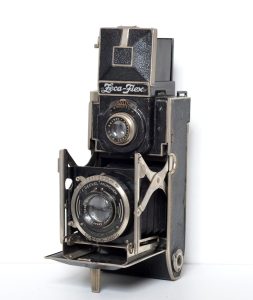
It would seem that Zeh’s business thrived, as by the early 1920s, he moved into camera production. The earliest Zeh models were typical “nickel and leather” style folding German cameras, but by the 1930s, their models improved in complexity. Perhaps the company’s most ambitious model was the Zeca-Flex from 1937, a folding twin lens reflex camera that was similar in style as the Welta Perfekta and Superfekta.
Besides the Zeca-Flex, Zeh produced a variety of other folding roll film and plate cameras such as the Bettax, Primus, Sport, and Goldi that were sold both under the “Zeca” brand, and as ‘white label’ models for other manufacturers. The Zeh Goldi being reviewed here can also be found as the Rodenstock Ysella, Herlango Renox, and Steinheil Speed Camera.
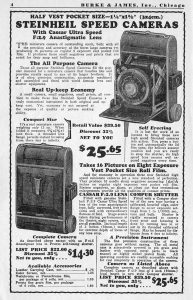
I could not find any type of period literature or advertising for the Zeh Goldi, but in the 1933 catalog for Burke & James of Chicago, there is an advertisement for the Steinheil Speed Camera, which was one of the rebadged variants of the Goldi. The Steinheil camera sold for $25.65 with the Cassar f/2.9 lens which when adjusted for inflation is comparable to just over $500 today.
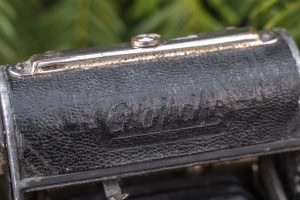
Although a rather obscure brand today, Zeh cameras were comparatively well built and shared many of the same high quality German shutters and lenses of other Dresden companies like Zeiss-Ikon, Welta, and Balda. In addition to their own success, the large number of Zeh built rebadged cameras means that there were likely far more produced than can be counted today. Further adding to the “mystique” surrounding the brand is that the cursive script logo used by Zeh causes them to often be mis-labeled as “ZECA”, “LECA”, and even “LEICA” cameras.
Most sources online suggest that the company continued operations until 1948, but I’ve found no evidence of any camera production after 1940. The area of Dresden was one of the most heavily hit by Allied bombers in February 1945, destroying nearly the entire city. My best guess was that in the early 40s, the Zeh factory and it’s workers teamed up with other Dresden area manufacturers, producing goods for the German war effort. The factory was likely destroyed, or heavily damaged, and the company ceased to exist at that point.
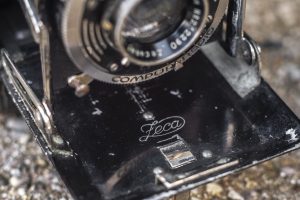
The area of Dresden would fall under Soviet control after the war, and like most East German camera makers in the area, by 1948 most were placed under the control of the State Government and merged into one of many Volkseigener Betriebs (VEB), or in English, Publicly Owned Enterprises. Since the company was small, and likely had little remaining resources, it would make sense that any form of legal business, would have ceased at that point.
Today, the Zeh Goldi is hardly a collectible brand or model, but it’s design as a pre-war German camera would make it generally appealing to most collectors. Pre-war Germany was well known for churning out these nickel and leather folding cameras, and most were quite capable little shooters. The Goldi itself has a unique design, and came with a Compur Rapid shutter and an f/2.9 Zecanar Anastigmat lens meaning that it compared favorably to most other cameras of similar design.
Repairs
I like pre-war nickel and leather German folding cameras for their looks and history, and I like 127 format cameras for their compact size, yet ability to still deliver detailed and sharp images. With a general interest in cameras like the Zeh Goldi, it wouldn’t take much arm twisting me for me to want to give one of these cameras a go. But when my friend and fellow collector Adam Paul repeatedly raves about a specific pre-war nickel and leather German folding camera that uses 127 film, I had to take notice.
Adam loved the Zeh Goldi so much that he has accumulated several and told me of one that was in sad condition and in dire need of some servicing. Always happy to help out a fellow collector, I had Adam send him his broken Goldi in the hope that I would be able to get it working again.
As promised, the Goldi showed up in all sorts of sadness. The shutter was stuck, the lenses were hazy, the camera’s hinges were stiff and creaky, the body was covered in rust, and Adam mentioned that he thought the focus was off. The camera was a wreck, but at least everything was there. The parts were in tact and the bellows appeared to be in good shape so I started tearing down the camera.
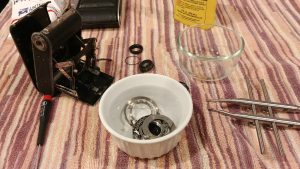
Normally, I try to take as many pictures of a camera repair to help potential other owners of a camera do the same job, but sadly, I didn’t do that this time. Instead, there’s just this one picture which I sent to Adam in the midst of repairing it.
Taking a part pre war German folders is mostly the same for most examples. Remove the lock ring on the rear of the shutter inside of the film compartment and the entire shutter comes off. Unscrew the front lens grouping from the shutter, and then remove all visible screws and you can get inside of the shutter.
From here, soak the entire thing in naphtha oil (lighter fluid) and keep cycling the shutter until it starts working properly. With a glass cleaner and some micro fiber cloths, I cleaned the lens elements and put them all back together once I had the shutter working.
The camera was still in very rough shape with the body covering peeling in many spots, plus rust in various other parts of the camera, but it worked, and thats all that mattered. Adam was excited to hear of my success with the Goldi and eagerly awaited my thoughts after shooting it.
My Thoughts
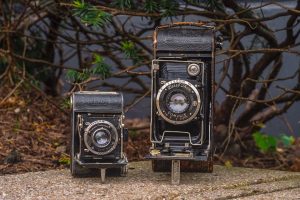
This thing is small. Most folding cameras made in the first third of the 20th century were generally pretty large. Cameras that used 116, 122, and 130 size film were quite common and are usually what most people think of when they think of a “nickel and leather” folding camera. The 127 format was originally considered “Vest Pocket” film as it was created by the Eastman Kodak company for their Vest Pocket cameras. The benefit of these compact cameras is their excellent combination of compactness with a relatively large exposed image that showed a lot of detail when enlargened.
This is not my first folding camera that uses 127 film. I’ve previously reviewed the Kodak Vollenda 48, and Foth Derby, both of which are equally small, but still, I am always a little unprepared each time I find a new one. Compared to a “postcard size” folding camera like the Zeiss Ikon Icarette 500/15 in the image to the right, the Zeh Goldi looks absolutely minuscule.
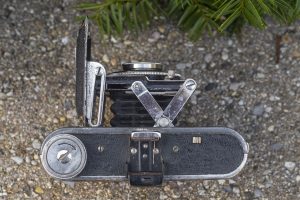
After getting over the tiny size of the Goldi, what you have is a pretty standard, but very well made, German folding camera. The viewfinder on the Goldi is of the folding type in which two hinged metal frames with glass elements pop up to reveal a straight through estimation of the exposed image. I’ve talked about this style of viewfinder before and find them to be extremely easy to use. The view through these is large, bright, and very easy to use with prescription eyeglasses and not to mention easy to clean. To the right of the folding viewfinder is the release for the front of the camera. A gentle press of this button pops open the front door of the camera.
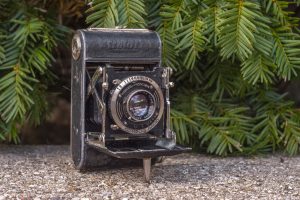
The Goldi has a self erecting design that automatically extends the bellows and shutter to the taking position. This particular example is over 80 years old and the spring that pushes the shutter out needs a little bit of help to reach the fully erect position, but once it’s there it locks into place. To close the camera again, there are two little round posts next to the mounting points of each scissor hinge, simply press in on both posts and you simultaneously release the lock and begin pushing the standard back into the camera body.
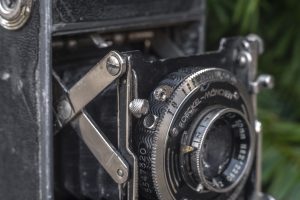
A nice feature of the Goldi that not every folding camera has is that it uses a “scissors” type of strut compared to a single sided strut like the Kodak Retina series uses. The obvious advantage to this is that the camera’s standard (the thing the shutter is mounted to) has equal pressure on all four corners, instead of two, which reduces any chance that the standard can fall out of parallel to the film plane. When a camera standard is not perfectly parallel with the film plane, images will never be properly in focus. A scissor hinge like on the Goldi is more complex and costly to make, but allows the camera to hold up better in the long run,
The Goldi uses a ring set Compur shutter which like all other ring set shutters, has the shutter speed selector around the outer perimeter of the shutter. This being a Compur-Rapid, there are speeds from 1 second to 1/500, plus T and B. Aperture f/stops are selected with a small little lever opposite of the shutter speeds, near the bottom of the shutter. The shutter release is on the shutter itself, near the shutter’s 7 o’clock position, and the cocking lever is above it, near the 10 o’clock position. Next to the shutter release is a threaded socket for a shutter release cable. One thing that sometimes throws off people unfamiliar with older Compur shutters like this, is that with the shutter set in either T or B mode, you do not need to cock the shutter first. Those two settings will work properly by moving the shutter release without needing to touch the cocking lever.
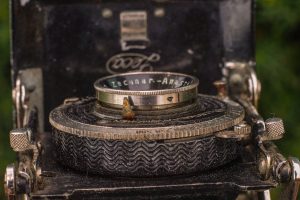
The focus scale on this Goldi is in feet rather than meters, which suggests it might have been made for export. I am unsure if there exist variants with a metric focus scale, or if they were all this way. Another interesting thing about the focus scale is that the closest marked distance is 4 feet, however the lens turns quite a bit beyond the 4 foot mark suggesting that it can focus a lot closer than 4 feet. Adam confirmed that in his testing, at the minimum distance, the camera focuses to 18 inches.
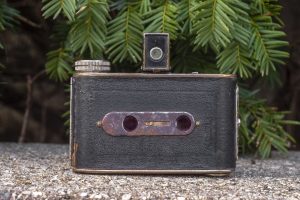
The back of the camera features twin peep holes with a red plastic window for viewing the exposure numbers on the film’s backing paper. There is a door that can be slid shut to protect light from entering these two red windows.
The Zeh Goldi is a “half frame” 127 camera that shoots sixteen 3cm x 4cm exposures per roll. Most 127 film lacks exposure numbers for half frame images, so you must use the full frame numbers from 1-8 for each exposure. How this is accomplished is as you advance the film, you must stop as each number appears in both windows. So for example, for the first exposure, stop when the number 1 is in the right window and take your photo. For the 2nd exposure, wind the film until the number 1 is in the left window. For the 3rd exposure, wind the film until the number 2 is in the right window, and so on. Always remember to use each number twice, once in the right window and then again in the left window. The 16th and final image will be exposed when the number 8 is seen in the left window.
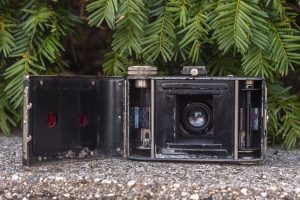
Loading film into the camera requires the door to be released via a sliding latch on the right side of the camera (while looking at the back) which reveals the left hinged film compartment. Like all roll film cameras, there are two compartments. An empty spool must be loaded on the take-up (left) side of the compartment and a fresh roll gets loaded on the right (supply) side. Simply stretch the paper leader from a new roll over the film gate, and thread it into the slit on the take up spool. Once you have the paper securely threaded, close the door, making sure it is securely latched and then turn the film advance knob until you see the number one in the right exposure peep hole.
There really isn’t much else to the Goldi. It’s quite an easy camera to use, and if you’ve ever shot any kind of folding German camera before (127 or otherwise), you should have no problems with it’s use. By far, it’s best asset is the small and compact nature of the camera. When folded it, it easily fits into a shirt pocket or a small purse. I won’t go as far as to say this was a “ladies” camera, but it would definitely be ideal for users with small hands.
My Results
With the loaner Zeh Goldi, Adam conveniently included a roll of 127 that he had cut from a larger roll of Kodak Portra 160 to shoot with it. The 160 speed film speed meant it should be ideal for sunny 16 with a 1/100 shutter speed. I shot the entire roll outdoors on a well lit day at a Veteran’s Memorial in Munster, Indiana.
I developed and scanned the roll of 127 at home as I have begun doing with most of my rolls this year. Normally when scanning, I crop all of my images to eliminate any of the edges from the film. When I saw the scans from the Goldi, I noticed they all had a wavy “distressed” look that I thought added to the images, so all of the images above intentionally include a little bit of the frame around each image. This camera was in very tattered shape and I sort of liked the idea of tattered images too.
In addition to the unique edges, I found the exposed film was quite dirty. This likely was due to the camera itself which was in pretty rough condition. As you can see in nearly every image earlier in this review, this camera has seen a lot of use. Much of the metal is rusted, the body covering is peeling in many places, and although still light tight, the bellows look like they’ve seen better days. Normally I would take better care to eliminate dust and specks on my film, but with this camera, I left it as is.
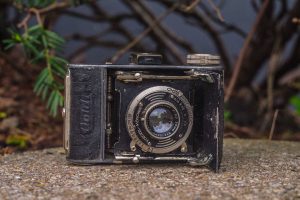
In use, the Zeh Goldi was a joy to use. I absolutely understand why Adam heaped so much praise on it. A combination of it’s compact and portable size, easy to use controls, and excellent shutter and lens combination make for a very fun camera to use. I shot the photo of the yellow flowers in the gallery above at the camera’s minimum focus distance, which is closer than most folding cameras are capable of.
Half frame 127 film gives you an exposed image that’s considerably larger than 35mm film, in a body that’s nearly the same size as other 35mm folding cameras. The biggest disadvantage of using the camera is the scarcity of 127 film. Of course it’s out there, but its not like you can just go to your family online photo retailer and order a 4 pack of fresh Kodak Portra 127.
These cameras don’t show up very often, and if you were to load up eBay and search for one right now, I’d be willing to bet there’s at least a couple there, but under an incorrect name, so you’ll need to get creative with various incorrect spellings of “Zeh”, “Zeca”, and “Goldi” to find one. If you do however, this is a gem of a camera that looks as good sitting on a shelf as it is in your hands with film loaded. Highly recommended.
Additional Resources
http://camera-wiki.org/wiki/Goldi
https://quirkyguywithacamera.blogspot.com/2017/09/zeh-not-meh-zeca-zeh-goldi-camera.html
https://vintagecameralab.com/zeh-goldi/
http://www.cjs-classic-cameras.co.uk/other/other.html
https://www.photo.net/discuss/threads/zeh-goldi-3×4-in-portra-nc-color.321558/
http://www.collection-appareils.fr/x/html/appareil-10067-Zeh.html

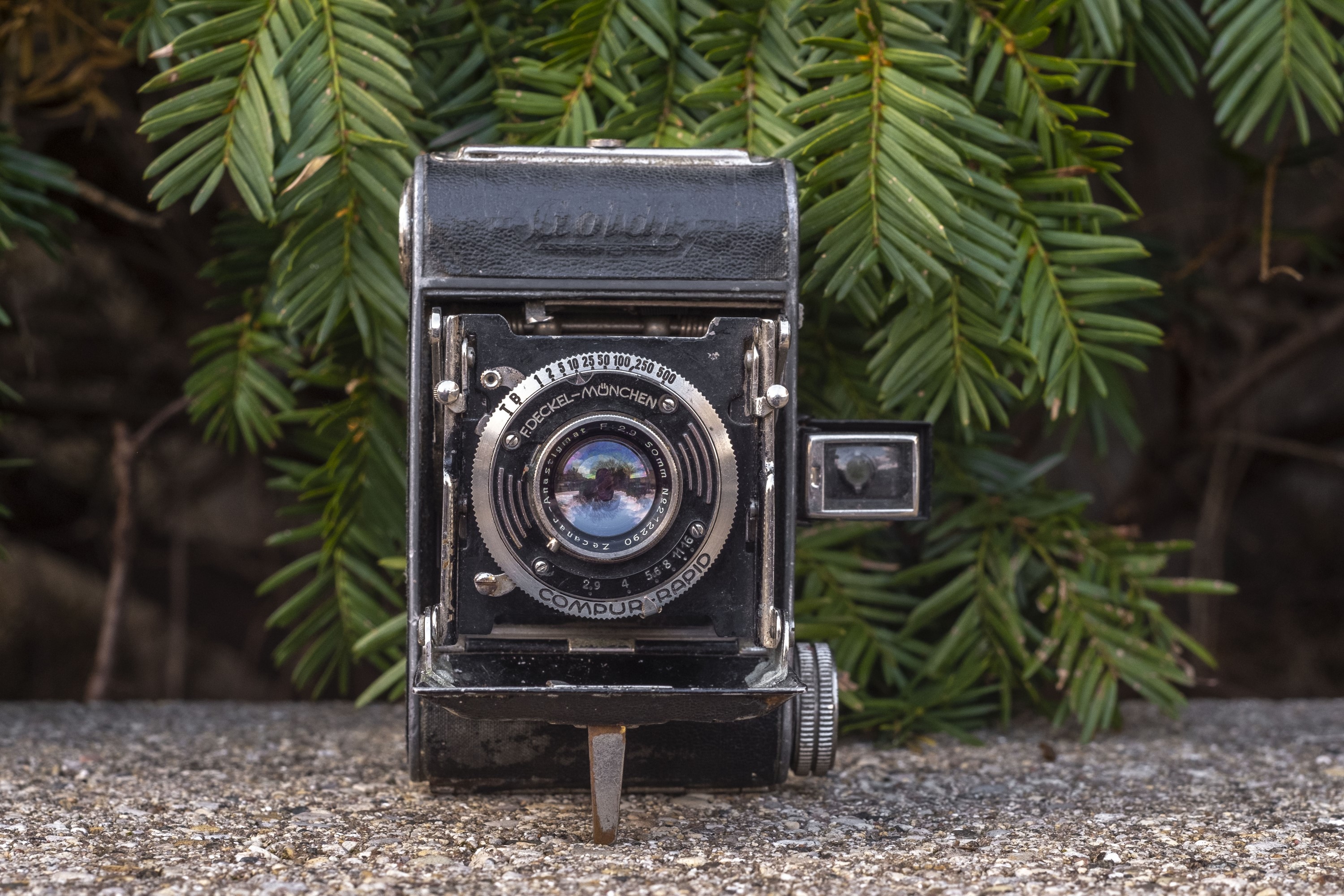
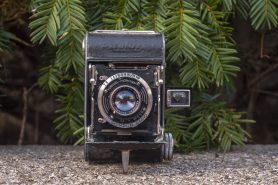
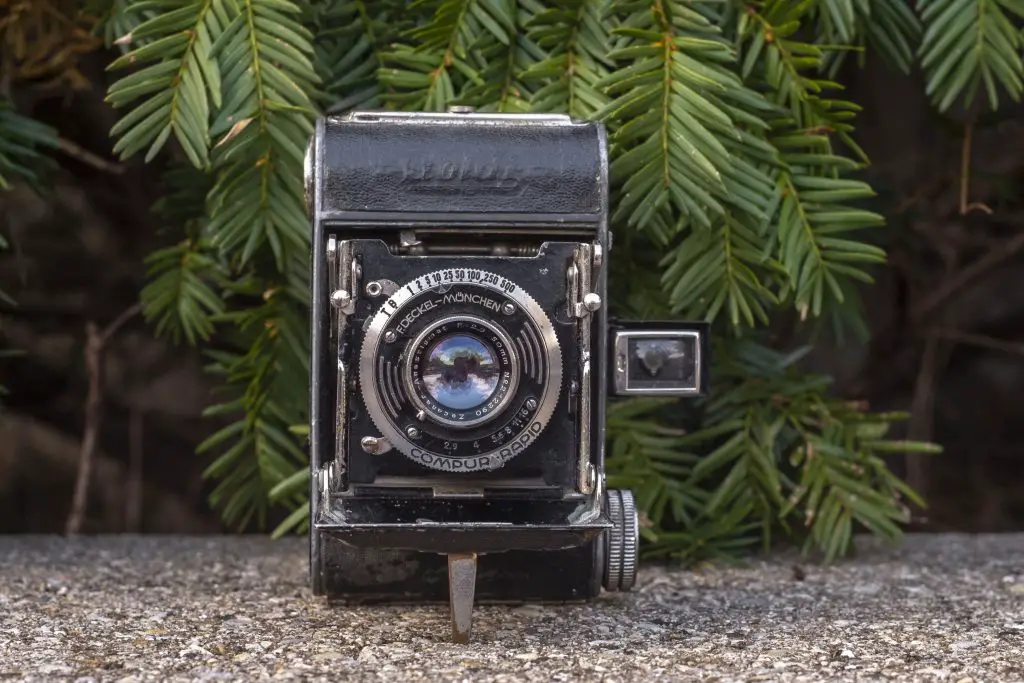









Really enjoy the articles and nice clear photos!
Great article. I found a lot of new and useful information.
Very informative read! Really enjoyed this! I just got a Zeh Goldie and am looking for 127 colour roll film. Any ideas where you can purchase online?
Great article…thanks for all your informative camera history. I acquired what I’m pretty sure is a Goldi half frame 127 folder at an estate sale in the KC area. It is a little different than the one featured in your article, in that it has a Prontor shutter and a f4.5 aperture. It also isn’t badge which made it a bit challenging to identify. It is pretty clearly a Goldi but I’m not sure why it doesn’t have the name anywhere. I’ve got some expired Verichrome Pan loaded and will test it out over the next few days.